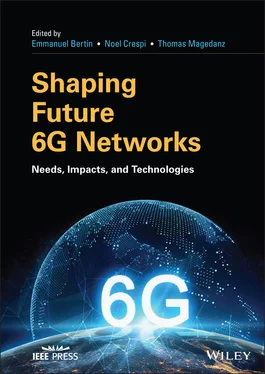Shaping Future 6G Networks
Здесь есть возможность читать онлайн «Shaping Future 6G Networks» — ознакомительный отрывок электронной книги совершенно бесплатно, а после прочтения отрывка купить полную версию. В некоторых случаях можно слушать аудио, скачать через торрент в формате fb2 и присутствует краткое содержание. Жанр: unrecognised, на английском языке. Описание произведения, (предисловие) а так же отзывы посетителей доступны на портале библиотеки ЛибКат.
- Название:Shaping Future 6G Networks
- Автор:
- Жанр:
- Год:неизвестен
- ISBN:нет данных
- Рейтинг книги:3 / 5. Голосов: 1
-
Избранное:Добавить в избранное
- Отзывы:
-
Ваша оценка:
- 60
- 1
- 2
- 3
- 4
- 5
Shaping Future 6G Networks: краткое содержание, описание и аннотация
Предлагаем к чтению аннотацию, описание, краткое содержание или предисловие (зависит от того, что написал сам автор книги «Shaping Future 6G Networks»). Если вы не нашли необходимую информацию о книге — напишите в комментариях, мы постараемся отыскать её.
Discover the societal and technology drivers contributing to build the next generation of wireless telecommunication networks Shaping Future 6G Networks: Needs, Impacts, and Technologies
Shaping Future 6G Networks
Shaping Future 6G Networks — читать онлайн ознакомительный отрывок
Ниже представлен текст книги, разбитый по страницам. Система сохранения места последней прочитанной страницы, позволяет с удобством читать онлайн бесплатно книгу «Shaping Future 6G Networks», без необходимости каждый раз заново искать на чём Вы остановились. Поставьте закладку, и сможете в любой момент перейти на страницу, на которой закончили чтение.
Интервал:
Закладка:
6G networks and services are expected to play a central role as the backbone of our future societies by tightly integrating virtual and physical spaces. Japanese governmental agencies have forged the term Society 5.0 to designate this future society that Japan should aspire to be. Following the hunting society (Society 1.0), agricultural society (Society 2.0), industrial society (Society 3.0), and information society (Society 4.0), Society 5.0 should achieve a high degree of convergence between cyberspace (virtual space) and physical space (real space). In this future Society 5.0, huge amounts of information from sensors in physical space are accumulated in cyberspace and analyzed by artificial intelligence (AI) to provide intuitive and near‐real‐time feedback to humans in physical space. This vision first drawn by science fiction authors in the early 1980s is about to become a reality. “Cyberspace… Data abstracted from the banks of every computer in the human system. Unthinkable complexity.” wrote William Gibson (who coined the term of cyberspace) in his 1984 novel Neuromancer .
The recent COVID‐19 misfortune might appear as a new step toward this Society 5.0, as we have re‐recognized the need for enhancing and upgrading information communication infrastructure to ensure the continuity of our social activities, as well as the growing blurring between virtual and real relationships. On this road, it is essential not only to promote research and development of technology but also to consider the global environmental impacts (such as carbon neutral and green recovery), the social inclusiveness so that no one will be left behind, and the ethics and social acceptability of these forthcoming technologies.
This wish for a future better and enhanced society shall be and remain the underlying foundation for designing future 6G networks. It should bond all the stakeholders engaged in research and development of next‐generation cyber infrastructure, 6G mobile network systems, to globally unite forces to define new requirements, use cases, and fundamental theories and technologies that must be realized for the next decade. These researches are also a way to progress for accomplishing the 2030 Agenda for Sustainable Development adopted by the United Nations in 2015, where one of the sustainable development goals is about building resilient infrastructure, promote inclusive and sustainable industrialization, and foster innovation.
Although it is just the very beginning of our journey for developing 6G mobile networking, we can assume that the next‐generation cyber infrastructure will bring us communications features very close to human capability, such as ultralow latency, ultra‐high capacity, ultra‐large number of connected devices, ultralow power communication, stringent security and privacy, autonomy enabled by machine learning and AI, and ultra‐coverage and extensibility including non‐terrestrial networks, underwater communication, etc.
This journey will not only be driven by the telecom industry. Many countries have allocated frequency white space to private 5G usage and made open to non‐telecommunication companies so that they can operate their own customized 5G networks. We believe that this “democratization” (i.e. making something accessible to anyone) of 5G networks will open a door to new innovations coming from the civil society as well as from industrial players. 6G will thus be the opportunity to conciliate various types of innovations: grassroots innovations coming from local players with new use cases and ad hoc solutions, radio and core layer innovations coming from Telco players, and also real‐time software innovations coming from Internet player. Besides the regular migration path from 5G to 6G promoted by telecommunication operators and vendors, there is another evolution avenue possible, from private 5G to private 6G and then to public 6G because a lot more stakeholders may participate in the game of developing custom solutions tailored for their real use cases that may be eventually distilled and adopted as viable 6G technologies to be standardized.
Along with the editors, I hope that this book serves as a navigating compass in our endeavor for developing 6G infrastructure for the next decade, by providing the insights from internationally known distinguished experts.
Akihiro Nakao
The University of Tokyo, Japan
Acronyms
| Abbreviation | Explanation |
|---|---|
| 3GPP2 | 3rd Generation Partnership Project 2 |
| 5G | 5th Generation |
| 5GAA | 5G Automotive Association |
| 5GC | 5G Core |
| 5G‐NTN | 5G Non‐Terrestrial Network |
| 6G | 6th Generation |
| AD | Anomaly Detection |
| AFL | Agnostic Federated Learning |
| AI | Artificial Intelligence |
| AIaaS | AI‐as‐a‐Service |
| API | Application Programming Interface |
| APS | Angular Power Spectrum |
| APSM | Adaptive Projected Subgradient Method |
| ARCEP | Autorité de Régulation des Communications Électroniques et des Postes |
| ARIB | Association of Radio Industries and Businesses |
| AS | Autonomous System |
| ASIC | Application‐Specific Integrated Circuit |
| ATIS | Alliance for Telecommunications Industry Solutions |
| B2B | Business‐to‐Business |
| B2C | Business‐to‐Consumer |
| B5G | Beyond 5G |
| BBUs | Baseband Units |
| BGP | Border Gateway Protocol |
| BN | Boundary Nodes |
| BOM | Business, Operation, and Management |
| BS | Base Station |
| BSS | Business Support System |
| BW | Bandwidth |
| CAPEX | Capital Expenses |
| CBRS | Citizen Broadband Radio System |
| CCNx | Content‐Centric Networking |
| CCSA | China Communications Standards Association |
| CDMA | Code Division Multiple Access |
| CeTI | Centre for Tactile Internet with Human‐in‐the‐Loop |
| CFN | Computer‐First Networking |
| C‐ITS | Cooperative Intelligent Transport System |
| CN | Core Network |
| COINRG | Computing in the Network Research Group |
| COTS | Commercial Off The Shelf |
| CP | Control Platform |
| CPM | Collective Perception Message |
| CPNP | Connectivity Profile Negotiation Protocol |
| CPU | Central Processing Unit |
| CR | Common Randomness |
| C‐RAN | Cloud‐RAN |
| CSAE | China Society of Automotive Engineers |
| CS | Channel Sounder |
| CSI | Channel State Information |
| CSI | Channel Side Information |
| CU | Centralized Unit |
| CUPS | Control User Plane Separation |
| D/A | Digital to Analogue |
| DCAE | Data Collection, Analytics, and Events |
| DC | Data Center |
| DDoS | Distributed Denial of Service |
| DetNet | Deterministic Networking |
| DFG | Deutsche Forschungsgemeinschaft |
| DI | Deterministic Identification |
| DINRG | Decentralized Internet Infrastructure |
| DMC | Discrete Memoryless Channel |
| DNN | Deep Neural Network |
| DoS | Denial of Service |
| DPI | Deep Packet Inspection |
| DRL | Deep Reinforcement Learning |
| DSCP | Differentiated Services Code Point |
| DU | Distributed Unit |
| EE | Energy Efficiency |
| EI | Enrichment Information |
| eLSA | Evolved License Shared Access |
| EM | Electromagnetic |
| eMBB | Enhanced Mobile Broadband |
| EROI | Energy Return on Energy Injected |
| ETSI | European Telecommunications Standards Institute |
| FD | Full Duplex |
| FDM | Frequency Division Multiplexing |
| FH | Fronthaul |
| FL | Federated Learning |
| FLOP | Float Point Operation |
| FPGA | Field‐Programmable Gate Array |
| FR2 | Frequency Range 2 |
| FSS | Fixed Satellite Service |
| FSS | Frequency Selective Surface |
| GDPR | General Data Protection Regulation |
| GEO | Geostationary Earth Orbit |
| gNB | Next‐Generation NodeB |
| GPP | General‐Purpose Platform |
| GPU | Graphics Processing Unit |
| GSM | Global System for Mobile Communication |
| GSMA | GSM Association |
| GTP | GPRS Tunnel Protocol |
| HAP | High‐Altitude Platform |
| HD | Half Duplex |
| HDFS | Hadoop Distributed File System |
| HDS | High Impedance Surface |
| HFT | High‐Frequency Trading |
| HMD | Head‐Mounted Device |
| HRV | High‐Risk Vendor |
| HTS | High Throughput Satellite |
| ICDT | Information, Communication, and Data Technology |
| ICT | Information and Communication Technology |
| IDF | Identification with Feedback |
| IMT | International Mobile Telecommunications |
| IoE | Internet of Everything |
| IoT | Internet of Things |
| IP | Intellectual Property |
| IPFS | Interplanetary File System |
| IRTF | Internet Research Task Force |
| ISL | Inter‐Satellite Link |
| ISTN | Integrated Space and Terrestrial Network |
| IT | Information Technology |
| ITU | International Telecommunication Union |
| JCSS | Joint Communication Sensor Systems |
| KPI | Key Performance Indicator |
| K‐V | Key Values |
| LEO | Low Earth Orbit |
| LF | Linux Foundation |
| LISP | Locator/ID Separation Protocol |
| LPWAN | Low‐Power Wide‐Area Network |
| LTE | Long‐Term Evolution |
| M2M | Machine‐to‐Machine |
| MAC | Media Access Control |
| MAMOKO | Molecular Communication |
| MC‐CDMA | Multi‐Code CDMA |
| MCTS | Monte Carlo Tree Search |
| MDA | Mandate‐Driven Architecture |
| MDAS | Management Data Analytics Service |
| MEC | Mobile Edge Computing |
| MEO | Medium Earth Orbit |
| mHealth | Mobile Health |
| MIMO | Multi‐Input Multi‐Output |
| MIoT | Massive IoT |
| ML | Machine Learning |
| M‐MIMO | Massive MIMO |
| MMSE | Minimum Mean Square Error |
| mMTC | Massive Machine Type Communications |
| MSS | Mobile Satellite Service |
| NAS | Non‐Access Stratum |
| NAT | Network Address Translator |
| NCSC | National Cyber Security Centre |
| NDN | Named Data Networking |
| NF | Network Function |
| NFV | Network Function Virtualization |
| NGP | Next‐Generation Protocols |
| NIA | Network Index Address |
| NIC | Network Interface Controller |
| NIN | Non‐IP Networking |
| NN | Neural Network |
| NOMA | Non‐Orthogonal Multiple Access |
| NRI | Non‐Randomized Identification |
| NRT | Non‐Real‐Time |
| NRT‐RIC | Non‐Real‐Time RAN Intelligent Controller |
| NSF | National Science Foundation |
| NWDA | Network Data Analytic |
| NWDAF | Network Data Analytics Function |
| OAM | Operation and Management |
| OBO | Output Back‐off |
| OBP | On‐Board Processor |
| OFDMA | Orthogonal Frequency Division Multiple Access |
| OPEX | Operational Expenditure |
| O‐RAN | Open Radio Access Network |
| OSC | O‐RAN Software Community |
| OT | Operation Technology |
| OTF | Open Testing Framework |
| OTIC | Open Testing and Integration Center |
| OTN | Optical Transport Network |
| P4 | Programming Protocol‐Independent Packet Processors |
| PAPR | Peak‐to‐Average Power Ratio |
| PCE | Path Communication Element |
| PCF | Policy Control Function |
| PE | Provider Edge |
| PFNM | Probabilistic Federated Neural Matching |
| PHY | Physical |
| PISA | Protocol‐Independent Switch Architecture |
| PLC | Programmable Logic Control |
| PN | Pseudo‐Noise |
| PS | Public Safety |
| PSCE | Public Safety Communication Europe Forum |
| QoE | Quality of Experience |
| QoS | Quality of Service |
| RAN | Radio Access Network |
| RANDA | Radio Access Network Big Data Analysis Network Architecture |
| rApp | Radio Application |
| RCA | Root Cause Analysis |
| ReLU | Rectified Linear Unit |
| RI | Randomized Identification |
| RIC | Radio Intelligent Controller |
| RIC | RAN Intelligent Controller |
| RIS | Reconfigurable Intelligent Surface |
| RKHS | Reproducing Kernel Hilbert Spaces |
| RLNC | Random Linear Network Coding |
| RRC | Radio Resource Control |
| RT | Real‐Time |
| SA | System Aspect |
| SBA | Service‐Based Architecture |
| SBI | Service‐Based Interface |
| SDL | Shared Data Layer |
| SDN | Software‐Defined Networking |
| SDO | Standard Development Organization |
| SDR | Software‐Defined Radio |
| SE | Spectrum Efficiency |
| SFC | Service Function Chaining |
| SFP | Service Function Path |
| SGD | Stochastic Gradient Descent |
| SLA | Service‐Level Agreement |
| SLA | Service Layer Agreement |
| SNR | Signal‐to‐Noise Ratio |
| SOM | Service Order Management |
| SRv6 | Segment Routing Based on IPv6 |
| TCO | Total Cost of Ownership |
| TDM | Time Division Multiplex |
| TDMA | Time Division Multiple Access |
| TIP | Telecom Infrastructure Project |
| TSDSI | Telecommunications Standards Development Society |
| TSN | Time‐Sensitive Networking |
| TTA | Telecommunication Technology Association |
| TTC | Telecommunication Technology Committee |
| TTI | Transmission Time Interval |
| UAV | Unmanned Aerial Vehicle |
| UDN | Ultradense Network |
| UMTS | Universal Mobile Telecommunication System |
| UN IPCC | United Nations Intergovernmental Panel on Climate Change |
| UP | User Plane |
| UPF | User Plane Function |
| URLLC | Ultrareliable Low‐Latency Communication |
| V2X | Vehicle to Everything |
| VHTS | Very High Throughput Satellites |
| VM | Virtual Machines |
| VNA | Vector Network Analyzers |
| VNF | Virtual Network Function |
| VPN | Virtual Private Network |
| VRU | Vulnerable Road User |
| VSAT | Very Small Aperture Terminals |
| WBD | Wireless Big Data |
| WWW | World Wide Web |
| YOY | Year over Year |
| ZB | Zettabytes |
| ZSM | Zero‐Touch Network and Service Management |
1 Toward 6G – Collecting the Research Visions
Интервал:
Закладка:
Похожие книги на «Shaping Future 6G Networks»
Представляем Вашему вниманию похожие книги на «Shaping Future 6G Networks» списком для выбора. Мы отобрали схожую по названию и смыслу литературу в надежде предоставить читателям больше вариантов отыскать новые, интересные, ещё непрочитанные произведения.
Обсуждение, отзывы о книге «Shaping Future 6G Networks» и просто собственные мнения читателей. Оставьте ваши комментарии, напишите, что Вы думаете о произведении, его смысле или главных героях. Укажите что конкретно понравилось, а что нет, и почему Вы так считаете.












